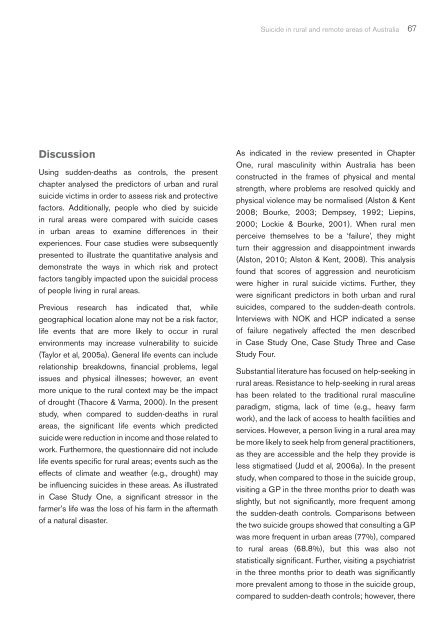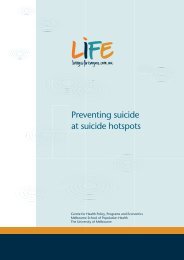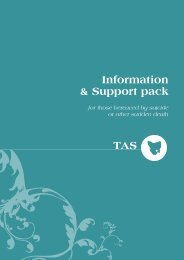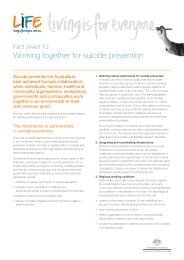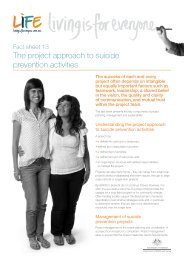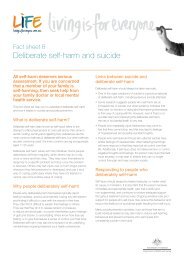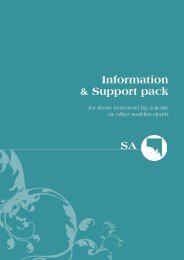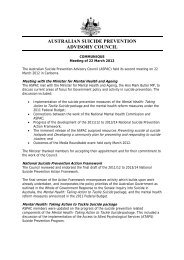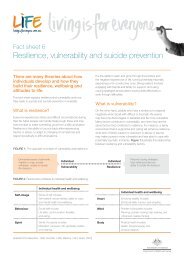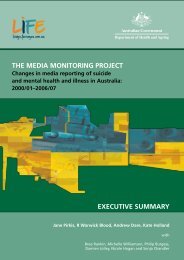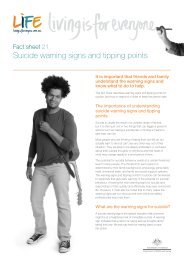SUICIDE in RURAL & REMOTE AREAS of AUSTRALIA - Living is for ...
SUICIDE in RURAL & REMOTE AREAS of AUSTRALIA - Living is for ...
SUICIDE in RURAL & REMOTE AREAS of AUSTRALIA - Living is for ...
You also want an ePaper? Increase the reach of your titles
YUMPU automatically turns print PDFs into web optimized ePapers that Google loves.
Suicide <strong>in</strong> rural and remote areas <strong>of</strong> Australia 67<br />
D<strong>is</strong>cussion<br />
Us<strong>in</strong>g sudden-deaths as controls, the present<br />
chapter analysed the predictors <strong>of</strong> urban and rural<br />
suicide victims <strong>in</strong> order to assess r<strong>is</strong>k and protective<br />
factors. Additionally, people who died by suicide<br />
<strong>in</strong> rural areas were compared with suicide cases<br />
<strong>in</strong> urban areas to exam<strong>in</strong>e differences <strong>in</strong> their<br />
experiences. Four case studies were subsequently<br />
presented to illustrate the quantitative analys<strong>is</strong> and<br />
demonstrate the ways <strong>in</strong> which r<strong>is</strong>k and protect<br />
factors tangibly impacted upon the suicidal process<br />
<strong>of</strong> people liv<strong>in</strong>g <strong>in</strong> rural areas.<br />
Previous research has <strong>in</strong>dicated that, while<br />
geographical location alone may not be a r<strong>is</strong>k factor,<br />
life events that are more likely to occur <strong>in</strong> rural<br />
environments may <strong>in</strong>crease vulnerability to suicide<br />
(Taylor et al, 2005a). General life events can <strong>in</strong>clude<br />
relationship breakdowns, fi nancial problems, legal<br />
<strong>is</strong>sues and physical illnesses; however, an event<br />
more unique to the rural context may be the impact<br />
<strong>of</strong> drought (Thacore & Varma, 2000). In the present<br />
study, when compared to sudden-deaths <strong>in</strong> rural<br />
areas, the signifi cant life events which predicted<br />
suicide were reduction <strong>in</strong> <strong>in</strong>come and those related to<br />
work. Furthermore, the questionnaire did not <strong>in</strong>clude<br />
life events specifi c <strong>for</strong> rural areas; events such as the<br />
effects <strong>of</strong> climate and weather (e.g., drought) may<br />
be <strong>in</strong>fl uenc<strong>in</strong>g suicides <strong>in</strong> these areas. As illustrated<br />
<strong>in</strong> Case Study One, a signifi cant stressor <strong>in</strong> the<br />
farmer’s life was the loss <strong>of</strong> h<strong>is</strong> farm <strong>in</strong> the aftermath<br />
<strong>of</strong> a natural d<strong>is</strong>aster.<br />
As <strong>in</strong>dicated <strong>in</strong> the review presented <strong>in</strong> Chapter<br />
One, rural mascul<strong>in</strong>ity with<strong>in</strong> Australia has been<br />
constructed <strong>in</strong> the frames <strong>of</strong> physical and mental<br />
strength, where problems are resolved quickly and<br />
physical violence may be normal<strong>is</strong>ed (Alston & Kent<br />
2008; Bourke, 2003; Dempsey, 1992; Liep<strong>in</strong>s,<br />
2000; Lockie & Bourke, 2001). When rural men<br />
perceive themselves to be a ‘failure’, they might<br />
turn their aggression and d<strong>is</strong>appo<strong>in</strong>tment <strong>in</strong>wards<br />
(Alston, 2010; Alston & Kent, 2008). Th<strong>is</strong> analys<strong>is</strong><br />
found that scores <strong>of</strong> aggression and neurotic<strong>is</strong>m<br />
were higher <strong>in</strong> rural suicide victims. Further, they<br />
were signifi cant predictors <strong>in</strong> both urban and rural<br />
suicides, compared to the sudden-death controls.<br />
Interviews with NOK and HCP <strong>in</strong>dicated a sense<br />
<strong>of</strong> failure negatively affected the men described<br />
<strong>in</strong> Case Study One, Case Study Three and Case<br />
Study Four.<br />
Substantial literature has focused on help-seek<strong>in</strong>g <strong>in</strong><br />
rural areas. Res<strong>is</strong>tance to help-seek<strong>in</strong>g <strong>in</strong> rural areas<br />
has been related to the traditional rural mascul<strong>in</strong>e<br />
paradigm, stigma, lack <strong>of</strong> time (e.g., heavy farm<br />
work), and the lack <strong>of</strong> access to health facilities and<br />
services. However, a person liv<strong>in</strong>g <strong>in</strong> a rural area may<br />
be more likely to seek help from general practitioners,<br />
as they are accessible and the help they provide <strong>is</strong><br />
less stigmat<strong>is</strong>ed (Judd et al, 2006a). In the present<br />
study, when compared to those <strong>in</strong> the suicide group,<br />
v<strong>is</strong>it<strong>in</strong>g a GP <strong>in</strong> the three months prior to death was<br />
slightly, but not signifi cantly, more frequent among<br />
the sudden-death controls. Compar<strong>is</strong>ons between<br />
the two suicide groups showed that consult<strong>in</strong>g a GP<br />
was more frequent <strong>in</strong> urban areas (77%), compared<br />
to rural areas (68.8%), but th<strong>is</strong> was also not<br />
stat<strong>is</strong>tically signifi cant. Further, v<strong>is</strong>it<strong>in</strong>g a psychiatr<strong>is</strong>t<br />
<strong>in</strong> the three months prior to death was signifi cantly<br />
more prevalent among to those <strong>in</strong> the suicide group,<br />
compared to sudden-death controls; however, there<br />
GriffithBook FINAL 20/09.<strong>in</strong>dd 67<br />
15/11/12 4:28 PM


